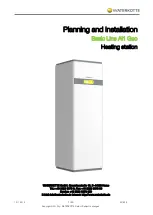
Omega II
®
Installation, Operation & Maintenance
Page 12
Combustion Research Corporation
GAS SUPPLY
WARNING
FIRE OR EXPLOSION HAZARD
IMPROPER INSTALLATION, ADJUSTMENT,
ALTERATION, SERVICE OR MAINTENANCE
CAN CAUSE DEATH, SEVERE INJURY
AND/OR PROPERTY DAMAGE.
Follow these warnings exactly.
1. Disconnect power supply before wiring to prevent
electrical shock or equipment damage.
2. To avoid dangerous accumulation of fuel gas, turn
off gas supply at the appliance service valve before
starting installation, and perform Gas Leak Test
after completion of installation.
3. Always install sediment trap in gas supply line to
prevent contamination of gas control.
Meter and service must be large enough to handle all the
burners being installed plus any other connected load.
When gas piping is not included in the layout drawing, the
local gas supplier will usually help in planning the gas
piping.
Support all gas piping with suitable suspension
materials and in accordance with local codes
Use wrought iron or wrought steel pipe and malleable
iron fittings. All pipe and fittings should be new and free
from defects. Ream the pipe ends and tubing ends to
remove obstructions and burs.
Use LP-gas resistant joint compound on all threads.
Apply only to male end of piping.
Check all piping, fittings and connections for leaks before
placing heating equipment into service. Use only soap and
water solution for checking for gas leaks, NEVER use and
open flame.
In industrial installations where the natural gas pressure at
the meter is available at higher pressure than the standard
7" TO 14" W.C., it may be possible to cut down on gas
piping costs (when local codes and the Fire Marshal
approve) by running high pressure gas lines inside the
building or on the outside of the building. In no case should
the pressure exceed 10% of the service supply pressure.
When using a high pressure gas distribution system each
heating zone should be equipped with a pounds to inches
service regulator with soft seat, positive 100% lock-up.
Allowing high gas pressure on the downstream side of the
regulator will damage the control valve in the gas train. The
outlet pressure of the service regulators should be set at 7"
W.C. for natural gas and 11" W.C. for LP gases/propane
gases. If it is not practical to regulate in "zones", each
burner may be equipped with its own regulator.
To meet the requirements of 100% positive lock-up and
internal relief vent must be piped to the outside of the
building. It is recommended that an intermediate service
regulator, such as a Maxitrol 325 Series or approved equal
be used.
The typical discharge pressure on the down stream side of
the gas meter furnished by the gas company is usually 5
P.S.I.G. while the discharge pressure of the regulator on the
propane tank is usually set at 15 P.S.I.G.
Proper sizing of low and high pressure piping distribution
systems for natural gas should be made in accordance with
the National Fuel Gas Code, ANSI Z223.1 (current
standard) NFPA No. 54. Consult the supplier of the
propane tank and vaporizing system for the sizing of the
piping system for LP gas pipe work.
When leak testing the gas piping system, the Omega II
®
burners must be isolated from the gas piping system. High-
pressure compressed air used in the leak test will damage
the control valve in the burner gas train, which will result in
unsafe operation of the burner(s). For proper and safe test
procedures, observe the provisions of Part #4, of the
National Fuel Gas Code, ANSI Z223.1 (current standard) -
Inspection, Testing and Purging
or refer to equivalent local.
In Canadian see gas code CAN/CGA-B149.1- M91.
NOTE: It is important that the entire system, up to the burner
gas connection, be checked for leaks, prior to start up.
GAS PIPE SIZING CHART
NATURAL GAS
LP / PROPANE GAS
Pipe
Size
Total Length of Pipe (feet)
Pipe
Size
Total Length of Pipe (feet)
20’ 40’ 60’ 80’ 100’
150’
200’
20’ 40’ 60’ 80’ 100’
150’
200’
½” 120 82 66 57 50 40 35 ½” 275 129
103 89 78 63 54
¾” 250 170 138 118 103 84 72 ¾” 567 267 217 185 162 132 112
1” 465 320 260 220 195 160 135
1” 1071 504 409 346 307 252 209
1-¼” 848 600 517 427 380 310 268 1-¼” 2205 1039 834 724 630 511 439
1-½”
1316 931 801 661 588 480 416 1-½” 3307 1559
1275
1086 976 787 665
PIPE CAPACITY - MBTU/HR
½” W.C. P.D. WITH 7.0” SUPPLY PRESSURE
PIPE CAPACITY - MBTU/HR
½” W.C. P.D. WITH 11.0” SUPPLY PRESSURE
!
Summary of Contents for Omega II
Page 40: ...Omega II Installation Operation Maintenance Page 36 Combustion Research Corporation...
Page 48: ......
Page 49: ......
















































